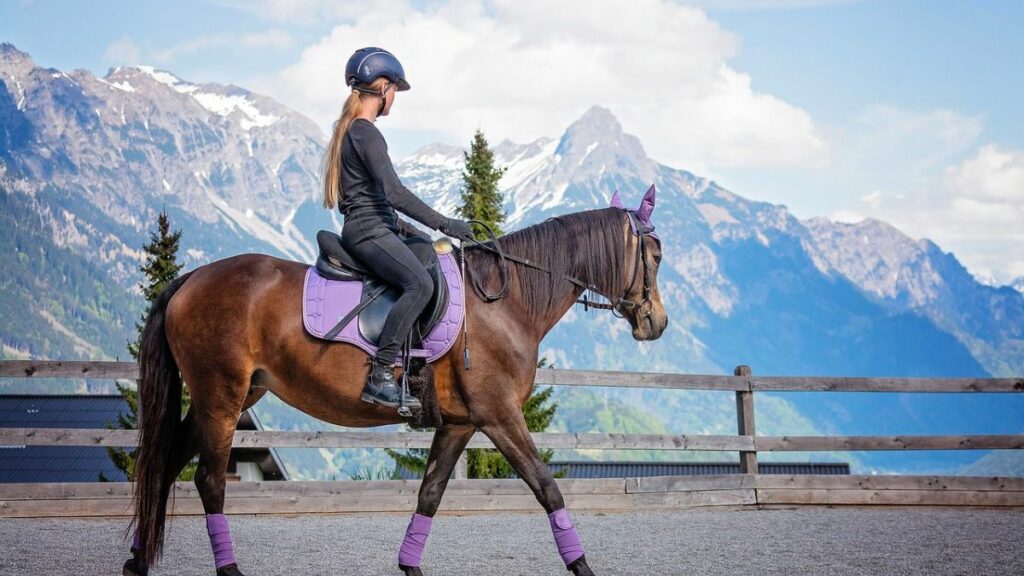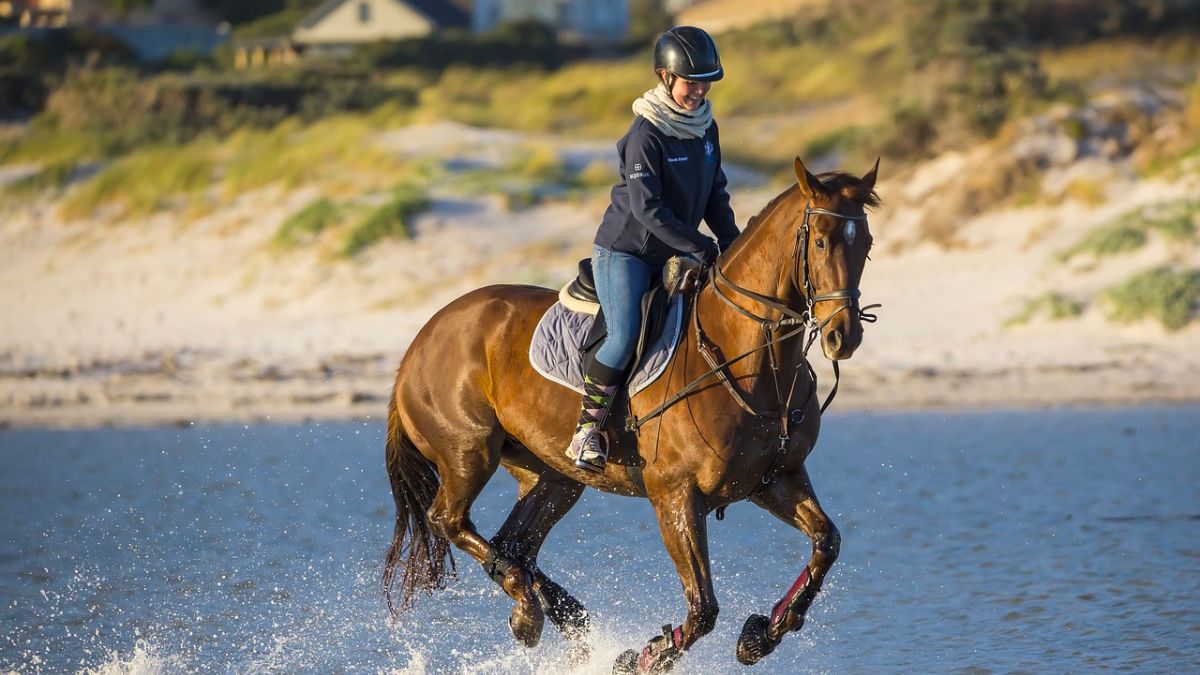Ride a Horse
Before you ride a horse, you need to understand how it works. You should also be aware of certain safety precautions.
To get the horse to walk, you need to apply moderate pressure with your reins and lean slightly forward in the saddle. You can also use your legs to communicate with the horse.
Saddle
When you are riding a horse, your feet are in stirrups that hook around the horse’s girth. Keeping your balance is important, so it is a good idea to wear boots that have a heel. They will protect your foot if it gets stepped on, and they will also prevent your foot from sliding all the way through the stirrups, which can happen even to experienced riders.
The first step to saddle up is to put your left foot into the stirrup and grab hold of the saddle horn with your right hand. You should have enough slack in the rein to allow the horse to move forward, but not so much that you cannot control it. It is important to remember that the reins are connected directly to the bit in the horse’s mouth, so never yank or jerk on them.
Before you mount, make sure that the girth or cinch is fastened securely. It is a good idea to ask someone to help you with this, as it can be dangerous for both of you if you try to do it yourself. Three girth straps hang from the saddle, but you only need to use the two outside ones. The middle one is present as a backup in case either of the other two break.
Once you are seated, rise with the horse by using your knees and thighs to swing up into the saddle. This is called “posting.” Once you have the hang of posting, you can ride at a walk, trot, and lope. At all gaits, your balance will shift and it is a good idea to keep your hands on the reins in order to maintain control.
Stirrups
You should use stirrups to help keep your balance when riding. A well-placed stirrup helps you stay upright, and it also allows you to reach down to aid your horse when necessary. In addition, it prevents the rider from falling off the horse, and it keeps the hands on the reins to maintain control over the speed of the horse.
When you are preparing to mount, you should step into the stirrup with your left foot, and the ball of the right foot should rest in the stirrup. Make sure that the stirrup is not too tight, and that it has enough space for your heel to drop down. This will keep you from jamming the foot in the stirrup and cause your feet to become locked into the stirrup.
You can judge the right stirrup length by placing your knuckles on the metal bar that the stirrup leather threads onto, or by measuring from your knuckle to the base of your armpit. However, this method will only give you a rough estimate of the proper stirrup length. It is more important to find the correct stirrup length by putting your foot into the stirrup while the horse is walking, and then to test your balance at different gaits.
After you have mounted the horse, take a hold of the reins with your left hand, and pull the horses head to the side that you want to turn. If the horse does not respond immediately, you should try a gentle pull on the rein to guide the horses head to the desired position. You should remember to pull the right rein for a right turn and the left rein for a left turn. You should not use a lot of force when turning the horse, because it could get uncomfortable for both you and the horse. To get the best result, you should be using both your legs and the reins.
If your foot is too long, the stirrup may slip down your heel, causing your weight to be carried forward of the centre of gravity. This can cause your knees to hurt, as well as throw your alignment off.
Leash

A horse’s lead rope is a vital piece of equipment for riding. A handler should know how to use it effectively, especially in a group setting. In addition to preventing other horses from running amok, it can also be used to teach the horse basic obedience and control commands. The handler should hold a single thickness of the lead in his or her right hand and gathered slack in the left. This will help the horse stay focused and prevent it from attempting to pull away. Avoid coiling or wrapping the excess line around your hand; this can cause you to be dragged and possibly injured.
Start by getting your gear ready. Check that your saddle is clean and secure, and that your bridle fits properly. You should also wear pants (not shorts, which will rub against the stirrup). If you’re a beginner, it may be helpful to bring a mounting block along to help you mount your horse safely.
When you’re ready to mount your horse, approach it from its near side and place your left foot in the left stirrup. Then, lift your right leg gently over the horse’s back and into the right stirrup. When you’re comfortable with walking your horse at a walk, you can move on to a trot. Remember, though, that you should always keep a safe speed and make sure that you can stop your horse when needed.
Once your horse is comfortable with the pattern, you can try a loping exercise. When you start this, your horse will likely be agitated and nervous, but it will eventually calm down. This will help him get accustomed to the pattern and learn that you’re in control of his feet.
Before attempting loping exercises, you should ensure that your horse knows how to walk. To teach a horse to walk, stand at the horse’s nose, and hold your lead rope in your hand while stroking its neck. Apply light pressure to the rope to encourage him to step over. Continue this exercise until your horse has responded to the pressure with a step over.
Lead rope
When a horse is first introduced to the lead rope, it may react by sniffing and investigating it. You should let it do this, and rub it gently against your body to reassure the animal that you are not harmful. If it begins to chew on the rope, raise your arms and calmly shoo it away. Once it has calmed down, snap the lead rope on and walk away from the horse so that it will not be able to see you.
Once the horse is comfortable with the lead rope, you should start walking it around. When you walk, hold the end of the lead rope in your right hand and use the pressure on the reins to guide the animal. Be sure to keep the pressure even as you move your legs to create more control.
During this exercise, you should also practice asking the horse to back up. To do this, wave the flag and then give the horse enough slack in the lead rope to get him to stand still. With your left hand, point at the horse’s hindquarters and create pressure with the rein to encourage him to step back. After the horse has taken a few steps, release the pressure and praise it for backing up.
When you are ready to mount, you should make sure that the girth is tightened and your stirrups are correctly adjusted. Stand at the horse’s side and grab the saddle horn with your left hand. Then, step your left foot into the stirrup and then throw your right leg over the horse’s rump. If the horse is spooky, you may want to practice this on the ground before trying it from a mounted position.
Before mounting, make sure that your seat and stirrups are comfortable. This will help you maintain your balance during the ride.
If you’re unsure how to attach the halter, talk to your horse in a soothing voice and use the words, “put on” and “clip on” as you try to place it on him. If the horse balks or resists, be patient and try again later.
Horse
Whether you’re a beginner or an experienced rider, it’s important to know how to properly mount a horse. Many people are intimidated by the idea of getting on a horse, but it’s actually quite easy if you know what to do. Ensure you’re wearing the proper attire, including a helmet, and don’t forget to secure your stirrups. Also, make sure to practice your equitation skills before riding. A good equitation requires years (often decades) of practice.
To begin, approach the animal calmly and place both reins in your left hand. Then, stand up and swing your right leg over its back. Be sure to move slowly to prevent frightening the animal or injuring yourself.
Once the horse is mounted, you can start riding! Keep in mind that horses can be nervous, so it’s important to stay calm and speak quietly to them. You can also pet them gently to help them feel more comfortable. If you’re unsure of how to do this, ask an experienced instructor for advice.
The horse’s main diet is tough grasses, which they eat with their long teeth called incisors. To maintain their health, they need to eat frequently. A healthy horse eats about two percent of its body weight in grasses every day.
To make a horse move, gently squeeze the sides of its body with your calves, and hold this pressure until it moves. Some horses may require more pressure than others, but you can usually get them to walk by squeezing them lightly. For some horses, this will be enough, but for other horses, you’ll need to add other signals simultaneously, such as making a click sound, leaning forward, and pushing the horse with a hip thrust.
If you want to teach your horse to move correctly, you’ll need to train it with its hind end engaged. If the horse isn’t engaging, it looks as though the back legs are dropping off the ground, their back is hollow, and their neck is inverted.
Before you try to squeeze your horse, make sure that you are calm and confident. If you are nervous and unsure of your abilities, the horse will likely become more nervous as well.










